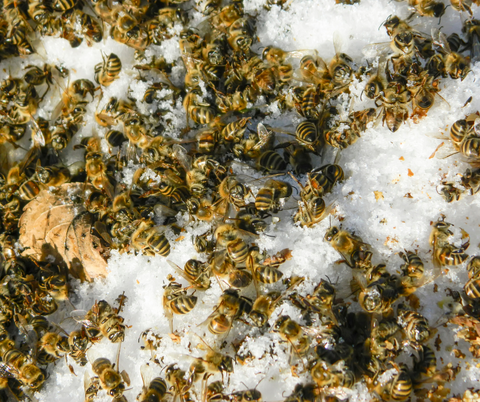What Do Bees Do in the Winter?
Throughout the year, our thoughts are on identifying carpenter bees and their annoying presence, but where do they go in the winter? The truth is that they hibernate inside their nests and colonies, and some don’t make it to spring. Life affects bees the way it affects all other aspects of life here on earth.

The beginning and end of the carpenter bee season begins in March to early April and ends in October to early November. Carpenter bees are famous for hovering near pools, eaves, decks, and facia boards on the house. They like to linger and drill holes in wooden patio furniture and framework on outbuildings.
Let’s keep reading to discover where bees go in the winter and how using the best carpenter bee traps from BeesNThings in late February to early March can reduce the number of carpenter bees on your property before they come out to play.
Why Does the Winter Cause Carpenter Bees to Hibernate?
The winter causes carpenter bees to hibernate because it is part of their natural cycle. They are active throughout the spring, summer, and fall. Carpenter bees like to stock up on their supply of nectar and pollen during the fall. They stockpile it in nearby abandoned tunnels and nests and hibernate over the winter.
Do Carpenter Bees Sting?
The answer is yes and no, depending on what type of carpenter bee we are discussing. Male carpenter bees hover around people and wooden objects and cannot sting. The female stays and protects her nests and will sting if handled.
Identifying Carpenter Bees
Identifying carpenter bees is hard because they look similar to a bumble bee. While a bumble bee has some yellow markings on its hairy abdomen, a carpenter bee has a shiny abdomen. Globally, more than 500 species of bees exist but most we never see here in the United States.
The US Has 3 Species of Carpenter Bees
Carpenter bees are between ¾” to 1” long and have black and yellow markings in the United States. The beginning and end of the carpenter bee season produce millions of new carpenter bees annually. They are an important pollinator for our ecosystem and vital to land regeneration.
Here are the three types of carpenter bees in America:
- Valley Carpenter Bee
These carpenter bees can grow up to an inch long and are yellow and robust. They can be found in the eastern Pacific Islands, Texas, and California. Valley carpenter bees love sweet nectar and drilling holes and tunnels into various wooden structures, fallen-down trees, and tree stumps.
- Orchard Mason Bee
These carpenter bees are covered in fuzz and have a blue color on their bodies. These carpenter bees do not drill holes. They make their nests in natural holes and reeds. Orchard Mason bees are found in Canada and the eastern US and hibernate in the winter like other carpenter bees.
- Eastern Carpenter Bee
These carpenter bees love drilling holes in wooden beams, wooden structures, wooden patio furniture, and trees. They also love eating nectar and pollen and making the queen happy by constructing nests, laying eggs, foraging, and drilling holes. Eastern carpenter bees live in Canada and the southeastern US.
Identifying carpenter bees is only half of the problem. Keeping them away from your wooden structures is another one. Online bee traps for sale at BeesNThings are a great way to trap and release carpenter bees without hurting them and keeping them from destroying your wooden components.
A Carpenter Bee Has 4 Stages of Life
Since carpenter bees are dormant and hibernate in the winter, they have a very repetitive lifestyle. Carpenter bees have four stages of life. Some die during winter, while new ones come to life in the spring.
The four stages of life for a carpenter bee include:
- Adult Carpenter Bees: Adult carpenter bees, after they hatch, leave the nest. They search for old or new nests to protect, drill, and continue with the lifestyle of the carpenter bee.
- Pupa Carpenter Bees: Pupa carpenter bees undergo an inactive stage and phase of metamorphoses. During this stage, young Pupa carpenter bees are easy prey and vulnerable. Therefore, protectors are right outside, keeping them safe while they mature.
- Larva Carpenter Bees: Larva carpenter bees feed larvae called “bee bread” to their young. It’s constructed from regurgitated pollen and nectar, the larvae encase them in silk while they mature inside and take 12-18 days to hatch.
- Egg Female Carpenter Bees: Egg female carpenter bees lay approximately six eggs each and form them into bread made from nectar and pollen. They take 2-3 days before hatching and get sealed in a chamber the worker bees made.
The best way to reduce a carpenter's bee infestation is to get high-quality bee traps designed to attract and catch the bees properly.
Where Can I Get Carpenter Bee Traps Before and After Winter?
The best place to get online bee traps for sale is at BeesNThings. We have a wide variety of carpenter bee traps that are eco-friendly and cost-effective. It’s always a good idea to get your bee traps before the winter season arrives and have them available to put out in the spring to reduce a carpenter's bee infestation.
For more information about our products and services, call or contact BeesNThings today.

